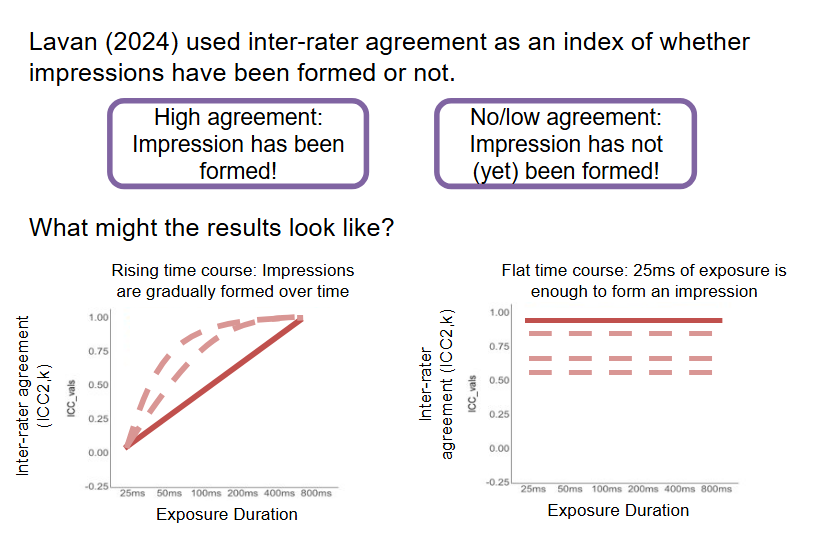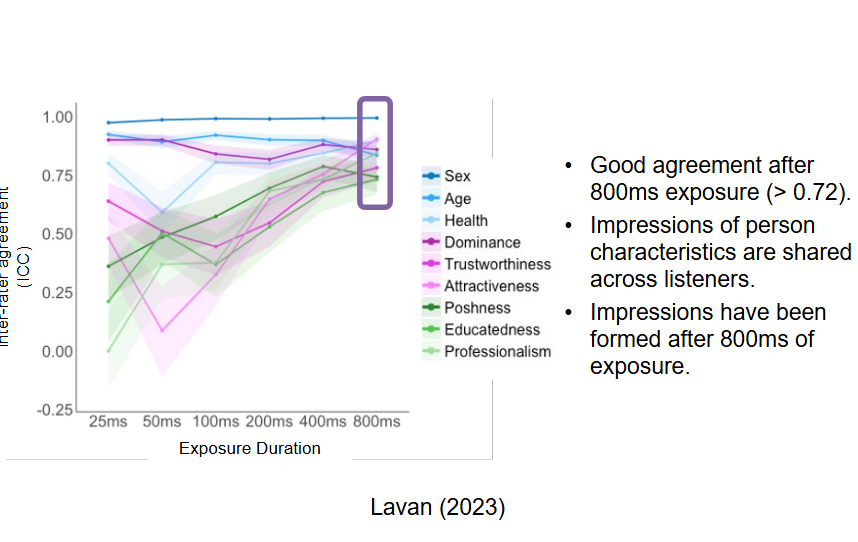Identity 2
1/19
There's no tags or description
Looks like no tags are added yet.
Name | Mastery | Learn | Test | Matching | Spaced |
|---|
No study sessions yet.
20 Terms
Person perception from unfamiliar voices
There has long been an interest in this:
Pear (1931) ran a radio experiment
9 unknown talkers were presented reading apassage from a Charles Dickens novel
Over 4,000 listeners completed a questionnaireabout the different talkers and posted it to thestation.
Listeners gave rich and detailed impressions ofthe people they heard.What kinds of information do peopleperceive in voices?
Physiology: Sex, age, height, strength, stateof health
Traits/personality: trustworthiness, dominance
Psychological/social: social status, accent,language background, sexuality
Let’s consider some examples
Perceiving physical characteristics Talker sex
Talker sex
Vocal dimorphism in humans is greatly exaggeratedcompared with other apes (Pisanski & Feinberg,2018)
Male F0 is on average 75% lower than female; formant spacing(related to timbre) 18% lower.
This is due to increases in vocal fold length, and a lowering of thelarynx, during puberty in males.
Perception of talker sex:
Can be done accurately (e.g. Lass, Hughes, Bowyer, Waters &Bourne, 1976)
And very rapidly (within 1.7 glottal cycles: Owren, Berkowitz &Bachorowski, 2007)
Perceiving physical characteristics SEX AND ATTRACTIVENESS
Sex and attractiveness
Studies of attractiveness from an evolutionaryperspective implicate F0 and formant frequencies
Females prefer male voices with lower pitch, and withreduced formant spacing (“vocal masculinity”)
Context-dependent: Low pitch preferred for short-termrelationship, but higher for long-term commitment
Complementary patterns for female voices (“vocalfemininity”)
See Pisanski & Feinberg (2018) for more
Perceiving physical characteristics HEIGHT AND WEIGHT
Height and Weight
Formant measures explain up to 10% of variance in Mand F height and weight (Pisanski et al., 2014)
But perceptual accuracy is quite low (Gonzalez, 2003).
Listeners may be relying on unhelpful stereotypes
e.g. They might assume low F0 = big, when F0 inreality only accounts for 2% of variation in actualbody size (Pisanski et al., 2014)
Perceiving physical characteristics AGE
Age
Again, estimations can be made but there isevidence for biases:
Smaller errors for child voices than young adultand older adult
Tendency to over-estimate age for young voices,under-estimate for older
Possible own-age bias: easier to estimate age forvoices around your own age
See Moyse, 2014
Perceiving physical characteristics BODY STRENGHT
Raine et al., (2018), iScience
Once again, people can make accurate relative estimates, but there are biases.
Dependent on context: greater perception of strength from roars than from speech in men.
Perceiving physical characteristics SUMMARY
SUMMARY
Listeners can make judgements aboutthe physical characteristics of talkers
Percepts of age, size, strength are madereadily and with some accuracy, butevidence for poor use of cues andlistener biases.
Perceiving traits
From Pear to today…
Pear asked his listeners to describe speakers based on passages of read speech.
But is this how we judge voices in real life?
In particular, from an evolutionary point of view, we might rather study our very first impressions of another person (or “thin-slice” judgements)
Todorov and colleagues did this with faces: found evidence that consensus on face traits is above chance from 33ms of exposure and doesn’t really improve after 167ms… (Todorov et al., 2009, Social Cognition)
McAleer et al. (2014), PLoS ONE
Recorded 64 talkers (32M, 32F) saying “hello”: abrief, and socially relevant, utterance.
Presented these to over 300 listeners who rated themon 10 scales: Aggressiveness, Attractiveness,Competence, Confidence, Dominance, Femininity,Likeability, Masculinity, Trustworthiness, Warmth
Used a Principal Components Analysis (PCA) toreduce the dimensionality of the data.
What is PCA?
PCA stands for Principal Components Analysis
PCA is a form of dimensionality reduction
In situations where you’ve got lots of different variablesthat you’ve measured (i.e. many dimensions), PCA canhelp to make the data more manageable andinterpretable.
For example, it’s much easier to understand how itemsvary on 2 or 3 dimensions rather than 10, 20, or 100s…
Perceiving traits McAleer
McAleer et al. (2014), PLoS ONE
Component 1 related to Trustworthiness, Component 2related to Dominance (similar to faces!)
Good inter-rater agreement (i.e. a trustworthy-soundingvoice sounds trustworthy to most listeners)
Interestingly, attractiveness loads more on Dominancefor male voices, and on Trustworthiness for females
How far do these perceptions generalise?
McAleer and colleagues have found similar patternsof trait perceptions in further studies:
Mahrholz, Belin, McAleer (2018): Generalisation acrossdifferent types of stimulus (words vs sentences; social vs non-social content)
Baus et al. (2019): Generalisation across different languages(English Spanish talkers)
This 2-dimensional solution aligns with findings for face firstimpressions, and for social perception more generally
e.g. the Stereotype Content Model’s dimensions of warmth andcompetence (Fiske and colleagues).
Acoustic correlates of traits?
Tsantani et al. (2016) created high and low F0 versions ofcontext-free words by female and male speakers
Listeners chose the most trustworthy or most dominantsounding version out each pair (2AFC task)
Dominance (High-Low F0) Trustworthiness (High-Low F0)
The low F0 version was perceived as more trustworthy formale and female speakers, and was perceived as moredominant for male speakers only
Low F0 was generally preferred in male voices, while it wasmore context-dependent for females.
Acoustic correlates of traits?
Belin, Boehme, McAleer (2017)created a morphed continuumbetween high and lowtrustworthiness “prototypes” fromtheir previous study.
Made “caricatures” (i.e. goingbeyond each end of thecontinuum): perceived as moreextreme in trustworthiness
Trust associated with higher andmore variable F0
Perceiving traits SUMMARY
Are first impression trait ratings accurate?
Kramer & Ward (2010)
Prepared composite face images offemale UG students who had ratedthemselves highest vs lowest on the Big 5traits (OCEAN – openness is labelled hereas intellect/imagination)
From High-Low pairs, participants had topick the image that matched the statemente.g. “More sympathetic” . Measured accuracy vs Chance *so above 50%(
Kramer & Ward (2010)
One some trials, showed the wholecomposite image (Full) and on others justthe face’s internal features (Internal)
Participants could discriminate 4/5 traitsfrom the internal features, and 3/5 from thefull face.
Are first impression trait ratings of voices accurate?
Materials from 93 German speakers
Voice recordings (2 spoken sentences)
Self-rated Big 5 scores
Other-rated Big 5 ratings (first impressions from N=30 listeners)
Experiment 1:
Made “trait averages” of the top 5 and bottom 5 M and F voices on each trait using the speakers’ self-ratings.
N=152 participants listened to pairs and chose the one matching the discrimination statement (e.g. “Which speaker is more likely to be outgoing and sociable?)
Experiment 2:
Made “trait averages” of the top 5 and bottom 5 M and F voices on each trait using previous listeners’ impressions ratings.
N=157 new participants listened to pairs and chose the one matching the discrimination statement (e.g. “Which speaker is more likely to be outgoing and sociable?)
Summary
Very limited evidence that listeners can perceive the “groundtruth” of personality from trait-averaged voices (Experiment 1).
More evidence in favour of stereotypes (Experiment 2): listenersagree with the ratings of other listeners about the perceived traitsof speakers.
Experiment 3 replicated above-chance perception of facepersonality ground truths
Also found some weak evidence for a correlation in this skill acrossfaces and voices.
This in principle could imply a cross-modality mechanism for(accurate) trait perception
Timecourse of person perception
Lavan (2023) found that listeners spontaneously suggestedwords about physical, personality, and social characteristicsto describe unfamiliar voices.
In a later study, Lavan (2024) decided to examine thesedifferent types of impression together
Person characteristics evaluated:
“Physical”: Sex, age, health
“Trait”: Attractiveness, dominance, trustworthiness
“Social”: Educatedness, “poshness”, professionalism
Research question: What is the timecourse ofimpression formation for these characteristics?

ask
100 voices were each presentedsaying “ahhh” for 25ms, 50ms, 100ms,200ms, 400ms, or 800ms.
Rated for the 9 traits
Rationale
800ms = should be enough to formimpressions of person characteristics(see “Hello” & McAleer’s findings).
25ms = probably too short?
Largely flat time course:High agreement throughout.
Physical characteristics areperceived within 25ms ofexposure.
Agreement for Sex > Age >Health.
Very different patternfrom physicalcharacteristics!
Rising time course:Impressions for socialcharacteristics evolvegradually.
Scope for agreement toincrease even after800ms?
Different trajectories forthe different traits.
Trustworthiness andattractivenessimpressions are formedgradually.
Although there are funnythings happening at 25ms
High agreementthroughout for dominance
Dominance agreement maybe influences by gendereffects

Vocal Identity II: Summary
Listeners can – and do – make judgements aboutaspects of an unfamiliar person’s identity based on thesound of their voice.
These judgements vary in accuracy.
Some judgements may not reflect reality (e.g. traits) butoften show good agreement across listeners.
Such “first impressions” may nonetheless be importantas they could affect the decisions listeners make aboutother people.